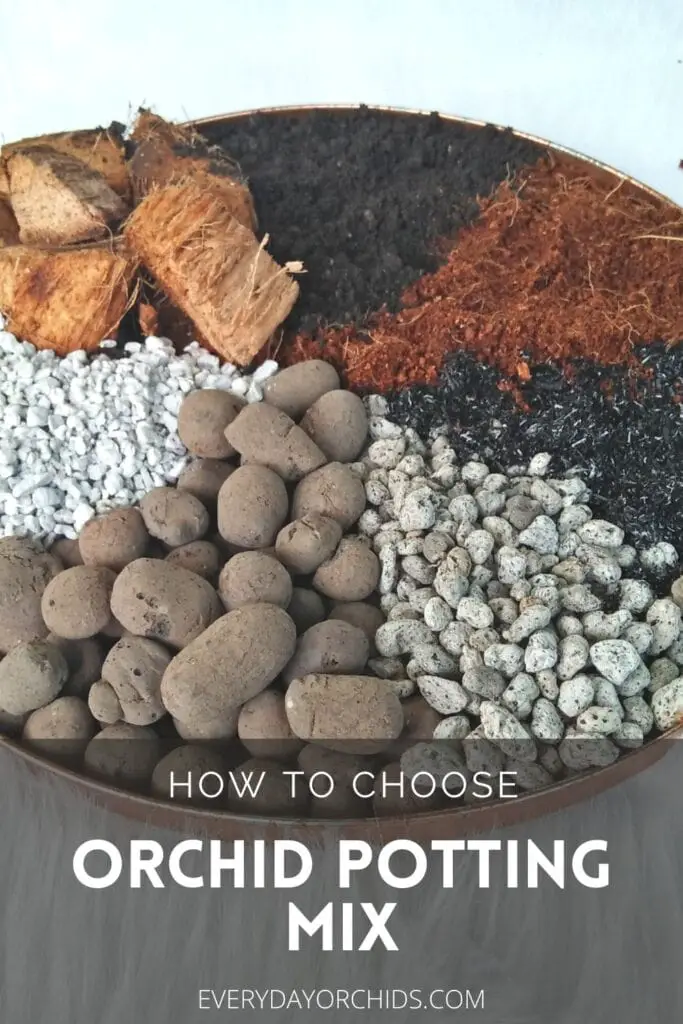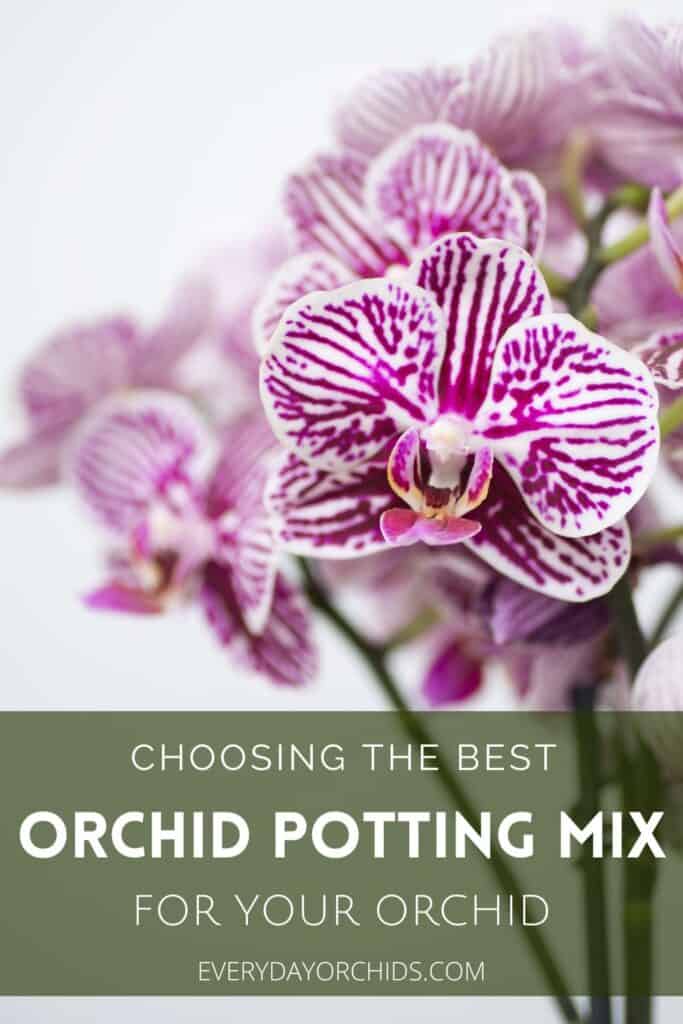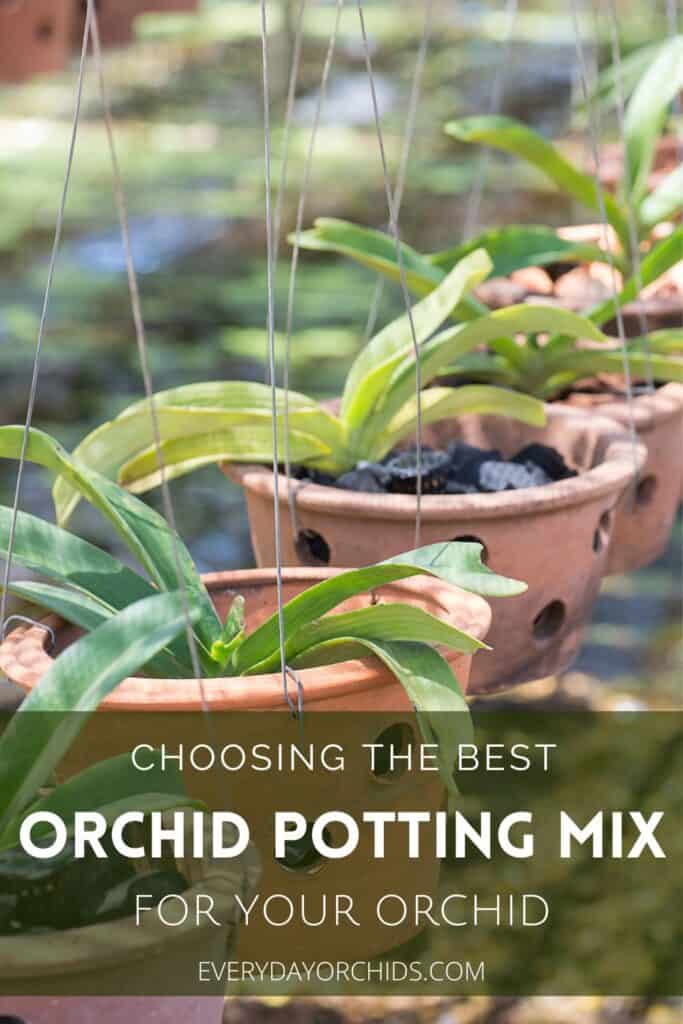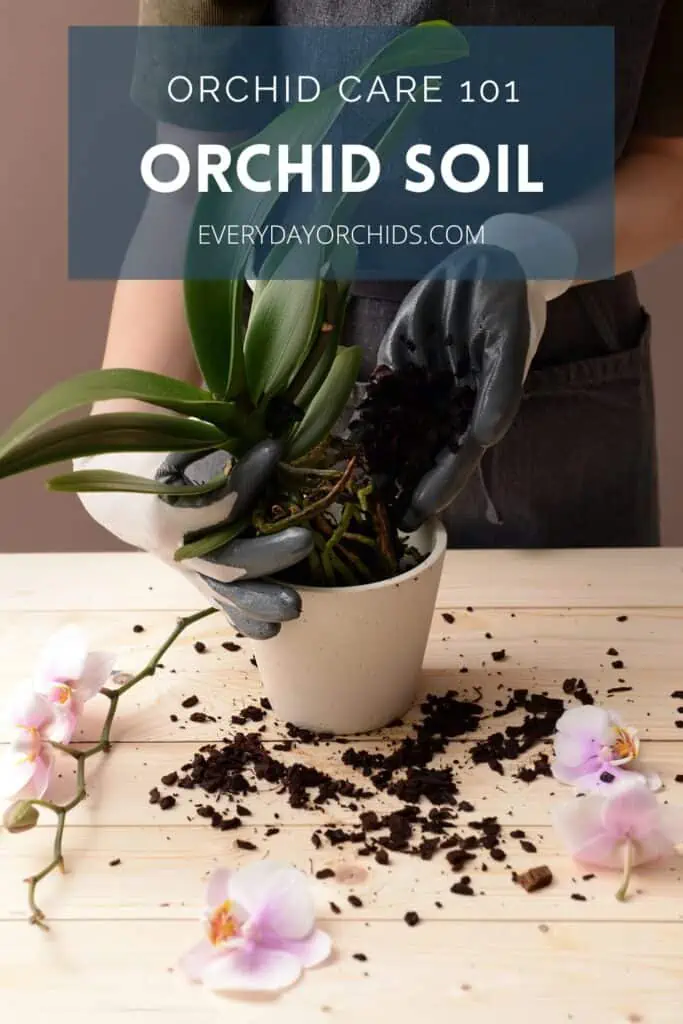When it comes to choosing an orchid potting mix and knowing what kind of orchid soil is best, the decision can feel daunting. After all, there is a huge variety of options out there, from orchid bark to soilless potting mix varieties, sphagnum moss and more.
Knowing what kind of potting mix to choose for your orchids boils down to your specific orchid’s needs. Different species have different care requirements in terms of watering and humidity levels. Once you understand your orchid’s specific care needs, you’ll be able to properly select the right orchid potting mix.
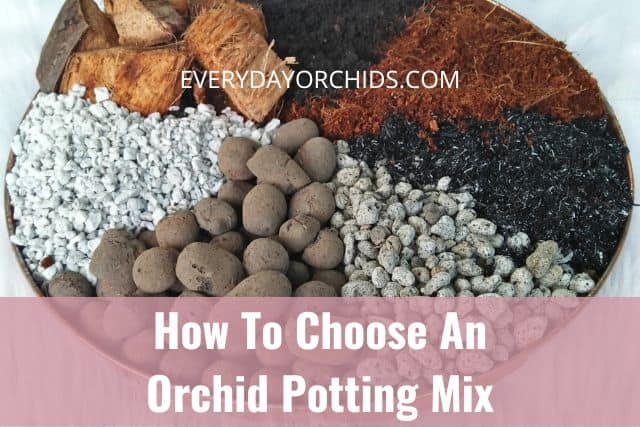
In this article, I’ll go over why orchids need a special type of potting mix. I’ll answer the question of whether you can use regular potting soil for orchids and what might happen if you do.
You’ll also learn about the different types of orchid soil and potting mix varieties available to buy. I’ll go over how to choose the best orchid potting mix for each type of orchid. Last, I’ll also give you some recommendations for the most popular types of orchid soil. Keep reading to learn more.
Please note that these links are affiliate links and as an Amazon Associate, I earn from qualifying purchases. Purchases made through affiliate links in this post may generate commissions at no additional cost to you. Use this link for a discounted Amazon Prime trial. Thank you for your support!
Table of Contents
Can I Use Regular Potting Soil For Orchids?
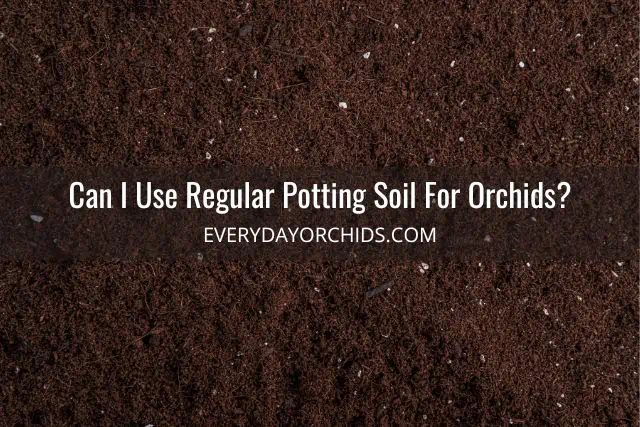
No, you cannot use regular potting soil for orchids. Unfortunately, regular potting soil is too dense and heavy for orchids and would quickly suffocate the roots.
Potting soil, like the kind that you would use in your garden or backyard, is made of a mixture of compost, peat moss, sand, perlite, and a few other components. The majority of the potting soil is comprised of compost and peat moss.
Regular potting soil is too heavy or dense for delicate orchid roots, which require gaps and airflow within the pot.
Most orchids are epiphytes. In the wild, they grow on the sides of trees and receive much of their nutrients from the surrounding environment.
Orchid roots are covered by a fine layer of velamen, a spongy cell layer that helps the orchid roots absorb water and nutrients from the air around them. Orchid roots need to breathe and have lots of air circulation in order to grow.
If you use gardening soil or regular potting soil for your orchids, your epiphyte orchid will soon begin to die.
You’ll soon see signs of root rot, wilted leaves, yellowing orchid leaves and other signs of stress. So while it may be tempting to just use potting soil for your orchid, just don’t do it.
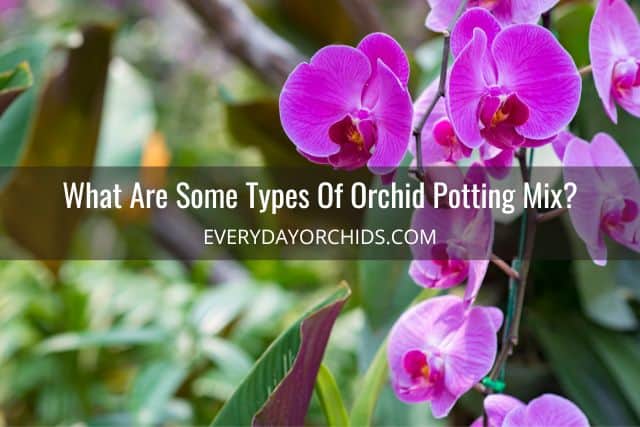
What Are Some Types Of Orchid Potting Mix?
Unlike potting soil used for houseplants or the garden, orchid potting mix is uniquely designed to meet the needs of orchids and their root structure. Potting mix for orchids is comprised of items that allow for airflow within the pot and quick evaporation of water.
Orchid Bark Mix
One of the most popular types of orchid potting mix are orchid bark blends.
Orchid bark mix, as you may have guessed, is primarily made of bark chips. Bark chips helps anchor the orchid in the pot, while the gaps between the chips allow for airflow and drainage. There are different sizes, or grades, of bark chips available. I’ll get into that more in the next section below.
Orchid bark mix is usually blended with smaller amounts of perlite, charcoal, and coconut coir. Depending on the manufacturer, you may also see bits of sphagnum moss or lava rock mixed in as well. All of these other components work to facilitate drainage or, in the case of sphagnum moss, retain moisture.
Sphagnum Moss
Another popular type of orchid potting media is sphagnum moss. About half of my orchids are potted in moss, while the other half are potted in orchid bark. I honestly like using both and don’t have a real preference for one over the other. Each has its own pros and cons, which you can read about more here: orchid potting media: bark vs. moss.
I will say, however, there is definitely a slight learning curve with growing orchids in moss. You’ll need to get used to the nuances of watering an orchid grown in moss. Sphagnum moss is more water-retentive than orchid bark, so you may find that you don’t need to water your orchids as frequently.
Usually most orchid bark mixes will contain a small amount of sphagnum moss. This helps retain some moisture in the orchid pot and prevents the orchid from completely drying out between waterings.
Hydroponics And Semi-Hydroponics
Orchids can also be grown using hydroponics or semi-hydroponics. Hydroponics involves water as the primary “potting medium.”
Meanwhile, semi-hydroponics usually involves a combination of water and clay pebbles. The clay pebbles support the roots and plant.
I’m currently growing two of my orchids in semi-hydroponics. It’s a new growing medium for me, so I haven’t written about it yet, but stay tuned.
Other Types of Orchid Potting Media
Less commonly, you may see lava rock, charcoal, pebbles, or gel beads used as an orchid potting medium. You can read more about these types of alternative orchid potting media here.
Some orchids may also be secured to a wooden board with wire and attached to a tree outdoors. In the case of Vanda orchids, these hanging orchids are often grown in slatted baskets outdoors.
All this to say, there are a lot of different options when it comes to potting orchids. Orchid bark mix and sphagnum moss are by far the most common types of orchid potting media, but they aren’t your only options.
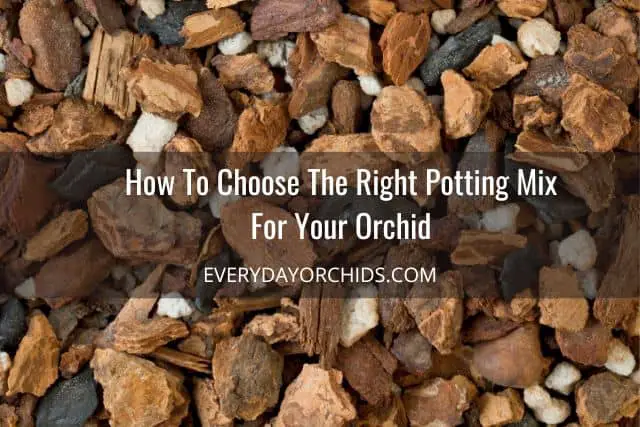
How To Choose The Right Potting Mix For Your Orchid
Choosing the right potting mix for your orchid is one of the key factors in whether it will thrive and grow or not.
Remember I said earlier that different orchid species have different care requirements? And therefore they will have different potting mix needs? Let’s dig in (hehe) to that more here.
Thick-Rooted Orchids
In general, orchids with thicker roots will need an orchid potting mix that contains either coarse or medium-size bark chips. These would generally be your monopodial orchids. Phalaenopsis orchids or Vanda orchids are examples of monopodial, thick-rooted orchids.
Older, more established orchids that are several years old (and thus bigger) should be potted with coarse or medium-sized orchid bark.
This is partly because larger orchids will use larger pots, and thus more potting mix. The more potting mix there is in the pot, the higher the chance that the potting media will stay wet longer.
Larger chunks of bark, such as that found in coarse bark mix, helps counteract this and allows for better airflow and water evaporation.
Thin-Rooted Orchids
Orchids with thinner roots, such as Miltoniopsis orchids, do better with orchid potting mixes containing fine, or smaller, bark chips. Thin-rooted orchids are sympodial orchids with pseudobulbs or terrestrial orchids.
Terrestrial orchids prefer higher humidity and moisture levels. They should be potted in a fine fir bark mix combined with rich hummus or compost for orchids.
Finer bark mix is more retentive of moisture and naturally provides higher humidity levels.
If you have a keiki orchid, I would also recommend using a fine bark mix or sphagnum moss as your main orchid potting media.
Keiki orchids, or young orchids, do better with higher humidity and moisture levels to help establish roots. Fine grade orchid bark is most ideal for these types of orchids.
Potting Media Grade
You’ll generally see the bark grade, whether coarse, medium or fine, notated on the bag. As I alluded to above, the grade of the bark chips tells you how big the bark chips are.
Coarse bark chips will be relatively large, while fine bark chips tend to be smaller.
In terms of the type of wood, fir bark or redwood bark chips are best. These types of wood tend to last longer and don’t degrade as quickly as orchid pine bark. However, most orchid potting mixes contain pine bark simply because pine is easier to source and less expensive.
I use pine bark orchid potting mixes for my orchids since that is easiest to find. However, I do repot my orchids every couple of years on average. This allows me to swap out the old potting media for new orchid potting mix and keep my orchids’ environment healthy.

What Is The Best Orchid Potting Mix?
The best orchid potting mix to buy is the one that is most accessible to you and works well with your orchid’s needs. While that may seem like a general answer, it is really true. However, just so you aren’t left hanging, here are a few of the best orchid potting mix varieties available online.
Best Overall Orchid Bark Mix
Perfect Plants makes a great all-around orchid potting mix for Phalaenopsis orchids. This is orchid potting bark mix is one of my favorites. It contains bark chips, sponge rock, charcoal, and coconut chips.
Like rePotme orchid mix (below), Perfect Plants sells their orchid potting mix in small, hand-blended batches. This ensures the potting mix will be fresh and the quality will be high.
Best Orchid Potting Mix For Phalaenopsis Orchids
rePotme Orchid Mix is another recommended orchid planting mix. These are sold in small hand-blended bags of orchid mix. Quality is excellent.
The bags are packed just before they are shipped out, meaning that your orchid potting mix will be fresh. There’s going to be little chance that you’ll find mold or bugs in the potting media. I mention this because bugs and mold is sometimes an issue with big-box stores, where potting media can sit for months before it is bought.
RePotme orchid mix sells different types of potting mix blends, based on the type of orchid you have. There are many different orchid mix blends available for Phalaenopsis orchids. They even sell an orchid starter kit, which includes orchid soil, orchid pots, clips for staking your orchid, and rePotme orchid fertilizer.
Most Inexpensive Orchid Bark Mix
Miracle Gro Orchid Potting Mix is one of the most popular orchid potting mixes available. It is sold online and in major stores, such as Home Depot, Lowe’s, and Walmart, making it easy to find. It is also fairly inexpensive. I can often find bags of this orchid potting mix for around $5.
Most Miracle Gro orchid potting mix bags sold are the coarse blend mix. I would recommend using this for larger, more established orchids. You can use this orchid potting mix for Phalaenopsis orchids, Epidendrums, Dendrobiums, and Cattleya orchids.
SunBulb Better Gro Orchid Mix is another highly-rated orchid bark mix. Like the Miracle Gro orchid potting mix, Better Gro orchid mix can be easily found online or in big-box stores such as Home Depot, Lowe’s and Walmart.
Better Grow orchid mix is usually my go-to orchid bark mix that I use for my Phalaenopsis orchids. It can also be used for Cymbidiums, Oncidiums, Dendrobium and Cattleya orchids.
Best Sphagnum Moss For Orchids
As I mentioned earlier, about half of my orchids are potted in sphagnum moss.
When choosing sphagnum moss, make sure you buy long-fibered sphagnum moss for orchids.
I’ve had readers ask me if Spanish moss from the tree would be okay to use, and unfortunately, the answer is no. That moss is untreated and not sterilized, meaning there could be pathogens in the moss that you don’t see. These could later affect your orchid’s health.
Instead, I’d recommend buying sphagnum moss from known brands. I personally use SunBulb’s Better Gro Orchid Moss. This is also readily available online and in major home and garden stores. A little bit goes a long way, so one “bale” will last you quite a long time.
Legigo Natural Sphagnum Moss Potting Mix is another great option for potting orchids.
Sphagnum moss is best used for younger orchids, such as keiki orchids, terrestrial orchids, or orchids requiring more humidity and moisture levels, such as Vanilla orchids, Jewel orchids and Monkey-faced Dracula orchids. I also like to use sphagnum moss when I am trying to save an orchid without roots or quickly grow orchid roots using a humidity box.
When handling sphagnum moss of any kind, make sure you wear gloves. Sphagnum moss can contain tiny sharp barbs. If they get lodged into your skin, they can be painful or even worse, lead to infection.
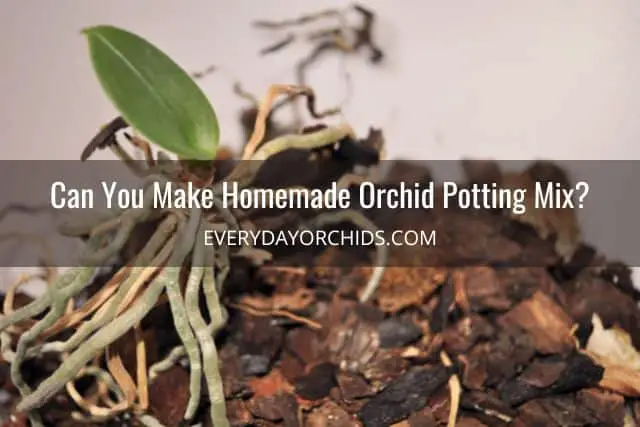
Can You Make Homemade Orchid Potting Mix?
You can absolutely DIY potting mix for orchids. The key is to know what your orchid’s needs are in terms of watering, humidity and drainage. Then, you can cherry pick which orchid potting mix components you’d like to use and in which ratios.
I’ll go over how to create your own homemade orchid potting mix in another post, so stay tuned for that step-by-step guide.
In the meantime, if you’d like to learn more about the purpose of each component in orchid bark potting mix, read this guide to orchid potting media. This will help you understand why you’d want to include things like bark chips, coconut coir, or perlite to your homemade orchid potting mix, and in what ratios.
You can also learn more about alternative orchid potting media here. There, I cover lava rock, gel beads, hydroponics and mounting your orchid.
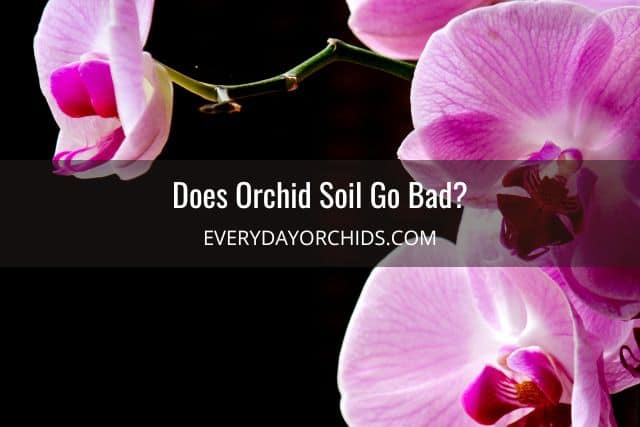
Does Orchid Soil Go Bad?
Yes, absolutely, orchid soil, or orchid potting mix, can go bad.
Orchid bark mix is organic and will naturally degrade over time. This is true even if it is in a sealed up bag and brand new. This is also why it is so important to carefully inspect your orchid potting media before use.
Key Indicators That Your Orchid Soil Has Gone Bad
- White streaks or a white powdery substance on the bark chips. This could be mold on the orchid potting media.
- Soft bark chips that are also darker in color. These bark chips have already started decomposing.
- Many small pieces of bark. As the orchid bark breaks down, you’ll see more and more smaller pieces of bark.
- A foul odor. Orchid potting mix should not have any particular scent to it, at least not that I’ve noticed. If it smells bad or malodorous, this likely indicates the presence of bacteria.
- Bugs! Orchid pests! If you open up a bag of orchid potting mix and see flies or bugs crawling around, throw it away. That is a bad batch. It’s likely contaminated and already decomposing.
If any of the above applies to your bag of orchid soil, throw it away. It’s no good! This is true even if it is a brand new bag.
While you could sanitize the potting media and try to salvage it, I personally would not bother. A new bag of orchid bark mix is less than $10 at the store. Save yourself some time and stress and just buy another bag.
Of note, orchid bark will naturally degrade overtime. As this type of potting mix decomposes, the bark chips will get darker and break down into smaller pieces. Given enough time, it will start to resemble dirt more than the original orchid potting mix.
The more decomposed the bark chips become, the less aeration you’ll have within the orchid pot.
As time goes on, more water will be retained. Your orchid will be at higher risk for root rot, fungus gnats, mold on the orchid roots and so on. You’ll want to repot your orchid long before this has a chance to happen.
On average, you’ll need to repot your orchids every one to two years with new orchid potting media.
Check out this step-by-step guide on how to repot orchids for more information on how to do this.
Does Sphagnum Moss Or Other Orchid Potting Media Go Bad?
Generally, you only have to worry about orchid soil going bad if it is an orchid bark mix.
Sphagnum moss is sold dried and doesn’t spoil. I keep my extra sphagnum moss in a sealed bag and just take out what I need when repotting.
Likewise, perlite, charcoal and lava rock do not go bad either. These orchid potting media components can last for ages if stored properly.
If you are growing your orchids in semi-hydroponics, the clay pebbles also can last indefinitely. I keep my extra LECA pebbles in a sealed ziploc bag and just take out what I need. If you do this too, don’t forget to sanitize them again before use. I would also recommend soaking them in a bucket of clean water for at least 24 hours before potting orchids with them.
Final Thoughts
Choosing an orchid potting mix takes some consideration, but it doesn’t have to be overwhelming. Think about what kind of orchid you have and what are its care needs. Then, match the potting media to the orchid.
When in doubt, medium-grade bark potting mixes will work well for Phalaenopsis orchids. If you are still unsure, most orchid potting mix bags will have a list of orchid species on the front of the bag. These are the orchid varieties that could be potted using that particular blend.
Selecting the right orchid potting mix is essential for your orchid’s health and future growth. However, proper lighting, humidity, watering and fertilization are other key factors in keeping your orchid healthy and blooming each year.
Check out the rest of Everyday Orchids for practical tips and guides on all aspects of orchid care. Thank you for reading!

